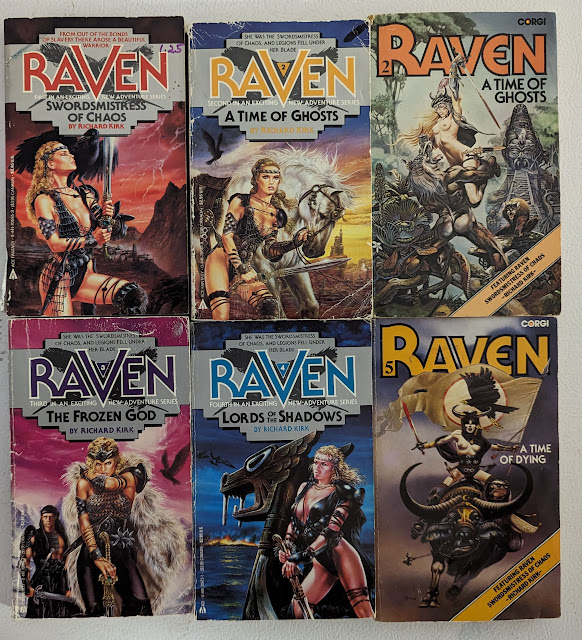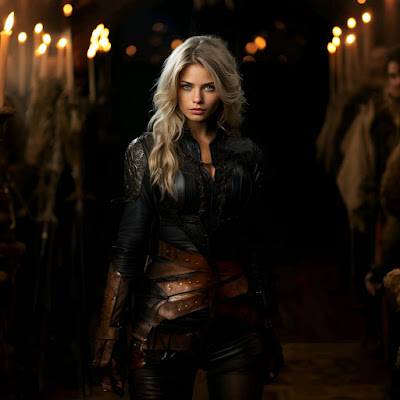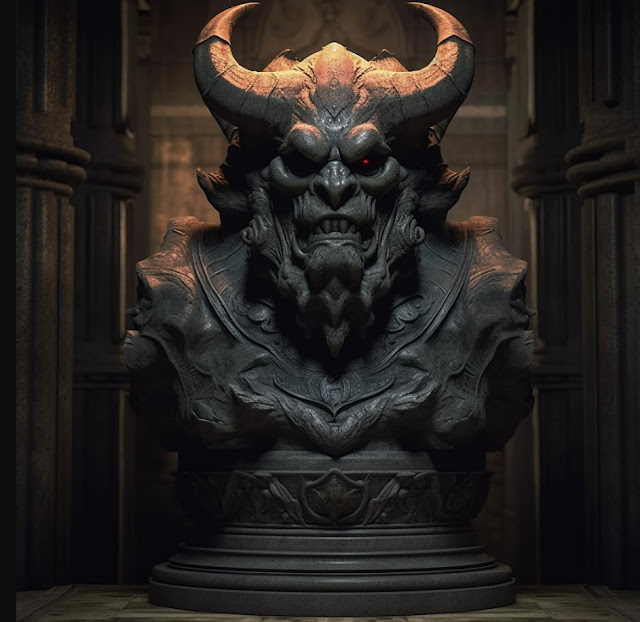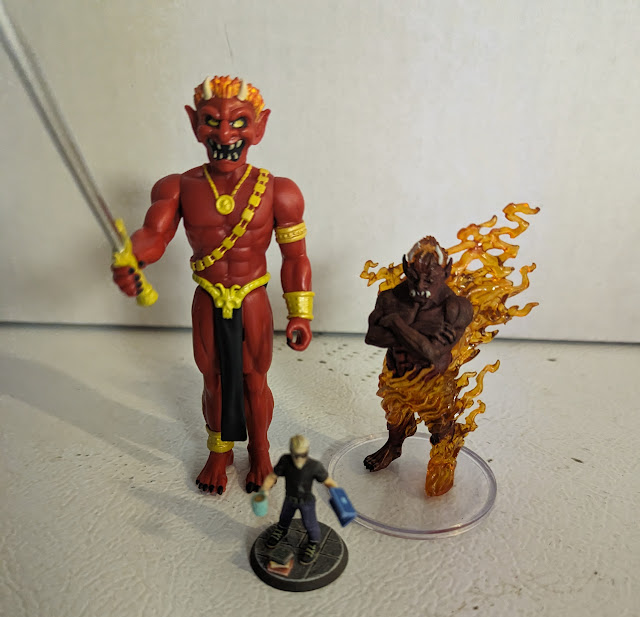Over the last couple of years, I have been on a quest to find and read all the Raven books by "Richard Kirk" who was, in reality, the pen name of authors Angus Wells and Robert Holdstock. Both wrote Book 1, and then they alternated with Wells on Books 3 and 5 and
Holdstock on Books 2 and 4.
Well, I succeeded in my quest and I found them all and read them.
While they are not...good...they are fun little romps in late 70s Swords and Sorcery (and Sex, but not as much as the Corgi covers hint at). Sometimes described as a mildly ribald Red Sonja or a less ribald Ghita Of Alizar. The books, however perfect for game fodder.
Raven as a Legendary Figure
While Raven is the cover girl and the eponymous main character, the warlock Spellbinder narrates and tells the events many years after the fact. Even the scenes where he was not present.
The story Raven begins with that of a runaway slave girl named Su'ann. She is rescued by a mysterious warlock-like character named Spellbinder, who recognizes that she is "the pivot on which the world turns" partially because she is also protected by giant raven, and he senses something in her.
Spellbinder and Su'ann, now calling herself "Raven," hook up with a band of outlaws and pirates. They go from adventure to adventure, but all the time, Raven is training with swords, spears, and what would become her "trademark," a set of throwing stars. It was the 70s, man. Raven, though is not training out of boredom, nor even for the higher purpose fate seems to have, but is very vague about, for her. She wants to kill her former slave owner, the Swordsmaster Karl Ir Donwayne.
The story is a simple one, but close to many FRP gamers. Raven wants to kill Karl Ir Donwayne. How is it going to do that? Well, they need to Skull of Quez to appease this ruler to get to Donwayne. But they have to find the mysterious island first and then kill some beastmen. And there are shadowy loners, men with mysterious pasts. Raven jumps in and out of bed with Spellbinder, Gondar the Pirate captain, and even Krya M'ystral, the Queen and sister of the ruler they were trying to go see. This is all in the first book. There is a nice gory battle with Karl Ir Donwayne too, but he comes back in future books to bother Raven some more.
It is very much a pastiche of Swords & Sorcery (& Sex) in a world lost to time. So perfectly set up for the Dreaming Age of the Wasted Lands.
Raven as a Character
Raven is a "pivot point" of Fate, an agent of chaos. She is, however, not "evil," so the traditional D&D Basic/BECMI alignment system doesn't work for her very well. She has no supernatural powers to speak of, but she is able to complete some feats of skill and combat that go beyond what is expected. Her raven guide is one example, her ability to master a number of weapons quickly is another. For a while, I thought she was akin to a NIGHT SHIFT "Chosen One" (and the similarities she shares with Buffy are pretty strong). I was reading over author/designer Jason Vey's posts about Class Abilities and customization that got me thinking that a Divine instrument character is also a good fit for the Would-Be/Could-Be gods that I have discussed already.
I have a concept. I have some good ideas. What Class in Raven?
The natural choice is "Warrior"; she is obviously that. But "Renegade" is also a great choice.
I could multi-class her, starting out in Renegade and advancing as Warrior. I could use some very limited Divine Touchstones to give her some flavor of the other classes.
I could even bring in the "Chosen One" class from NIGHT SHIFT. Since they are 100% rules compatible.
In the Wasted Lands RPG, there is an Appendix for character point buy building. Essentially you pick and choose the ability you want your "class" to have and build it up that way. Except there is no class and no class level, every ability has a level.
Raven has aspects of Warrior, aspects of Renegade, and even some Chosen One and Survivor (both from Night Shift).
So, what can Raven do? Going through the list of abilities, I see Raven is very close to the Night Shift Chosen One and the Wasted Lands Warrior, minus a few abilities and adding a few more. Her abilities are:
Brutal Warrior (Leveled) (10 xp per scaled)
Melee Combat (5 xp)
Stunning Blow (10 xp)
Killing Blow (15 xp)
Supernatural Attacks (5 xp)
Sixth Sense (5 xp)
Improved Defense (5 xp)
Ranged Combat (5 xp)
Extra Attack (2) (15 xp per)
Vitality Dice 1d8 (Leveled) (5 xp)
Plus, the following from Renegade and Survivor:
Stealth Skills (Leveled) (10 xp per scaled)
Climbing (10 xp per)
Sneak Attack x3 (5 xp per)
Each one of these abilities has an XP value attached to it and some are "leveled." I *could*, in theory, keep all of these leveled ones at the same levels and build an XP advancement for her custom "class," but keeping them all on separate "levels" allows even greater customization. She has some stealth skills, but despite being a pirate at times, being a "thief" is not part of her history. Sure, she does do it, but her prowess with a sword (Brutal Warrior) and throwing stars (Ranged Combat) is more important.
I wanted to ensure she gets Supernatural Attacks since she fights zombies/the undead and even a "God." Though this god is more akin to the servants of the Old Ones or an Old One himself.
Other Abilities
These are great, and I love how it is all working out together. But what about her other abilities? Such as the part about being an agent of Fate, or her raven companion? In other words, what makes her a Wasted Lands character and not just a generic D&D fighter?
Simple. This is exactly what the Divine Touchstones are for.
Raven has not overt magic. She doesn't even have supernatural abilities other than what is stated above. But there is something...extra about her. The Divine Touchstones allow me to codify these. For this I am sticking with the ones in the Core Rules. I can see her getting a +1 to melee combat (to cover how she was already a capable fighter), a Favored Weapon benefit for her throwing stars, and of course a "Spirit Guide" in the form of her raven.
Putting it all Together
Putting this together, I get a great customized character that perfectly fits the concept of what I want.
Raven, Swordsmistress of Chaos
Class: Custom (XP buy)
Level: 6
Species: Human (Primate)
Alignment: Light Neutral (Twilight leaning)
Abilities
Strength: 16 (+2) A
Agility: 17 (+2) N
Toughness: 15 (+1) N
Intelligence: 12 (+0)
Wits: 13 (+1)
Persona: 17 (+2)
Fate Points: 10
Defense Value: 5
Vitality: 30 (6d8 +6)
Degeneracy:
Corruption:
Check Bonus (A/N/D): +4/+2/+1
Melee Bonus: +7 (see below)
Ranged Bonus: +4 (Throwing Stars +5) (see below)
Saves: +2 to all
Abilities
Brutal Warrior (Level 6) (10 xp per scaled)
Melee Combat (5 xp)
Stunning Blow (10 xp)
Killing Blow (15 xp)
Supernatural Attacks (5 xp)
Sixth Sense (5 xp)
Improved Defense (5 xp)
Ranged Combat (Level 2) (5 xp per)
Extra Attack (2) (15 xp per)
Vitality Dice 1d8 (Level 6) (5 xp per)
Stealth Skills (Leveled) (10 xp per scaled)
Climbing (10 xp per)
Sneak Attack x3 (5 xp per)
Divine Touchstones
1st: +1 Melee Combat
2nd: Favored Weapon (Throwing Stars)
3rd: Spirit Guide (Raven)
Divine Notes: Agent of Fate
Background: Former Slave
Gear
Sword, leather armor, buckler, daggers, throwing stars, net
Ok! I like how she worked here. These are superior to her BECMI stats I did a while back. While she made for an interesting Dungeons & Dragons character, her nature and her world are much more similar to the Wasted Lands than they say to Mystara, the Forgotten Realms, or Krynn.
This also shows off how powerful the customization is in the Wasted Lands RPG. Any character concept is possible. This sort of customization is more "expensive" than, say a by-the-book character, but I am fine with that, to be honest, to get the character I want.

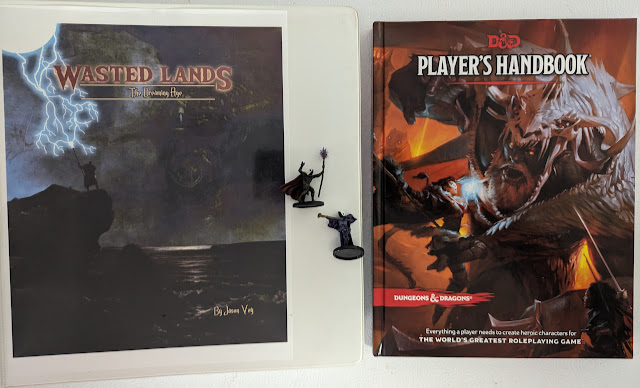
.png)


